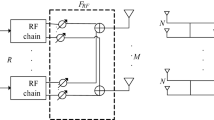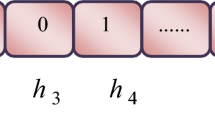Abstract
Energy efficiency (EE) plays a significant role in the progress towards the Fifth-generation (5G) wireless communication networks. Massive multiple-input multiple-output (MIMO) is a viable concept for the 5G networks due to the greater SE and EE. In this work, a Channel Selection (CS) scheme is proposed by selecting the optimal channel using the Chicken Swarm Optimization (CSO) algorithm. A massive MIMO model is implemented by considering the SE and EE. The main objective is to optimize the beam-forming vectors and power allocation for all the users. The multi-objective function can be defined to develop an effective and robust design with balanced SE and EE. The objective function for generating the optimal beam forming vectors is satisfying the signal to interference-plus-noise ratio (SINR) constraints. Based on the channel characteristics, the CSO Algorithm is used to produce the beam-forming vectors and power distribution. A projection matrix with a channel estimating framework is created once the channel state information is predicted. The selection of the index sets in the iteration process provides the optimized channel. Data transmission is performed through the optimal channel. According to the comparison analysis, the suggested CS scheme offers superior SE and EE to the existing CS schemes.







Similar content being viewed by others
Data Availability
Data sharing is not applicable as no datasets were generated or analyzed during this study.
Code Availability
The code generated during this study is available with the corresponding author.
References
Tan, W., Jin, S., Wen, C.-K., & Jiang, T. (2017). Spectral efficiency of multi-user millimeter wave systems under single path with uniform rectangular arrays. EURASIP Journal on Wireless Communications and Networking, 2017(1), 181.
Fan, L., Zhao, R., Gong, F.-K., Yang, N., & Karagiannidis, G. K. (2017). Secure multiple amplify-and-forward relaying over correlated fading channels. IEEE Transactions on Communications, 65(7), 2811–2820.
Ngo, H. Q., Larsson, E. G., & Marzetta, T. L. (2013). Energy and spectral efficiency of very large multiuser MIMO systems. IEEE Transactions on Communications, 61(4), 1436–1449.
Marzetta, T. L. (2010). Noncooperative cellular wireless with unlimited numbers of base station antennas. IEEE Rransactions on Wireless Communications, 9(11), 3590–3600.
Lu, L., Li, G. Y., Swindlehurst, A. L., Ashikhmin, A., & Zhang, R. (2014). An overview of massive MIMO: Benefits and challenges. IEEE Journal of Selected Topics in Signal Processing, 8(5), 742–758.
Larsson, E. G., Edfors, O., Tufvesson, F., & Marzetta, T. L. (2014). Massive MIMO for next generation wireless systems. IEEE Communications Magazine, 52(2), 186–195.
Rusek, F., et al. (2012). Scaling up MIMO: Opportunities and challenges with very large arrays. IEEE Signal Processing Magazine, 30(1), 40–60.
Pan, G., et al. (2016). On secrecy performance of MISO SWIPT systems with TAS and imperfect CSI. IEEE Transactions on Communications, 64(9), 3831–3843.
He, A., Wang, L., Elkashlan, M., Chen, Y., & Wong, K.-K. (2015). Spectrum and energy efficiency in massive MIMO enabled HetNets: A stochastic geometry approach. IEEE Communications Letters, 19(12), 2294–2297.
Murmann, B. (2017). ADC performance survey 1997–2016. http://www.stanford.edu/murmann/adcsurvey.html.
Risi, C., Persson, D., & Larsson, E. G. (2014). Massive MIMO with 1-bit ADC. arXiv preprint arXiv:1404.7736.
Choi, J., Mo, J., & Heath, R. W. (2016). Near maximum-likelihood detector and channel estimator for uplink multiuser massive MIMO systems with one-bit ADCs. IEEE Transactions on Communications, 64(5), 2005–2018.
Li, Y., Tao, C., Seco-Granados, G., Mezghani, A., Swindlehurst, A. L., & Liu, L. (2017). Channel estimation and performance analysis of one-bit massive MIMO systems. IEEE Transactions on Signal Processing, 65(15), 4075–4089.
Mollen, C., Choi, J., Larsson, E. G., & Heath, R. W. (2016). Uplink performance of wideband massive MIMO with one-bit ADCs. IEEE Transactions on Wireless Communications, 16(1), 87–100.
Zhang, J., Dai, L., Sun, S., & Wang, Z. (2016). On the spectral efficiency of massive MIMO systems with low-resolution ADCs. IEEE Communications Letters, 20(5), 842–845.
Zhang, Z., Chen, Z., Shen, M., & Xia, B. (2016). Spectral and energy efficiency of multipair two-way full-duplex relay systems with massive MIMO. IEEE Journal on Selected Areas in Communications, 34(4), 848–863.
Zhang, J., Dai, L., He, Z., Jin, S., & Li, X. (2017). Performance analysis of mixed-ADC massive MIMO systems over Rician fading channels. IEEE Journal on Selected Areas in Communications, 35(6), 1327–1338.
Chen, X., Wang, X., & Chen, X. (2013). Energy-efficient optimization for wireless information and power transfer in large-scale MIMO systems employing energy beamforming. IEEE Wireless Communications Letters, 2(6), 667–670.
Lee, J.-H., & Lee, J.-Y. (2017). Optimal beamforming-selection spatial precoding using population-based stochastic optimization for massive wireless MIMO communication systems. Journal of the Franklin Institute, 354(10), 4247–4272.
Todnatee, S., & Phongcharoenpanich, C. (2016). Iterative GA optimization scheme for synthesis of radiation pattern of linear array antenna. International Journal of Antennas and Propagation,, 2016.
Khodier, M. M., & Al-Aqeel, M. (2009). Linear and circular array optimization: A study using particle swarm intelligence. Progress In Electromagnetics Research, 15, 347–373.
Saxena, P., & Kothari, A. (2016). Ant lion optimization algorithm to control side lobe level and null depths in linear antenna arrays. AEU-International Journal of Electronics and Communications, 70(9), 1339–1349.
Singh, U., & Salgotra, R. (2018). Synthesis of linear antenna array using flower pollination algorithm. Neural Computing and Applications, 29(2), 435–445.
Mahto, S. K., & Choubey, A. (2015). A novel hybrid IWO/WDO algorithm for interference minimization of uniformly excited linear sparse array by position-only control. IEEE Antennas and Wireless Propagation Letters, 15, 250–254.
Jayaprakasam, S., Rahim, S. K. A., & Leow, C. Y. (2015). PSOGSA-Explore: A new hybrid metaheuristic approach for beampattern optimization in collaborative beamforming. Applied Soft Computing, 30, 229–237.
Sun, G., Liu, Y., Zhang, J., Wang, A., & Zhou, X. (2016). Node selection optimization for collaborative beamforming in wireless sensor networks. Ad Hoc Networks, 37, 389–403.
Y. Li, C. Tao, L. Liu, G. Seco-Granados, and A. L. Swindlehurst, "Channel estimation and uplink achievable rates in one-bit massive MIMO systems," in 2016 IEEE Sensor Array and Multichannel Signal Processing Workshop (SAM), 2016: IEEE, pp. 1–5.
He, A., Wang, L., Chen, Y., Wong, K.-K., & Elkashlan, M. (2017). Spectral and energy efficiency of uplink D2D underlaid massive MIMO cellular networks. IEEE Transactions on Communications, 65(9), 3780–3793.
Patcharamaneepakorn, P., Wu, S., Wang, C.-X., Alwakeel, M. M., Ge, X., & Di Renzo, M. (2016). Spectral, energy, and economic efficiency of 5G multicell massive MIMO systems with generalized spatial modulation. IEEE Transactions on Vehicular Technology, 65(12), 9715–9731.
Yang, J., Wang, H., Ding, J., Gao, X., & Ding, Z. (2017). Spectral and energy efficiency analysis for massive MIMO multi-pair two-way relaying networks under generalized power scaling. Science China Information Sciences, 60(10), 102303.
Xin, Y., Wang, D., Li, J., Zhu, H., Wang, J., & You, X. (2015). Area spectral efficiency and area energy efficiency of massive MIMO cellular systems. IEEE Transactions on Vehicular Technology, 65(5), 3243–3254.
Tan, W., Xie, D., Xia, J., Tan, W., Fan, L., & Jin, S. (2018). Spectral and energy efficiency of massive MIMO for hybrid architectures based on phase shifters. IEEE Access, 6, 11751–11759.
Nimmagadda, S. M. (2020). Optimal spectral and energy efficiency trade-off for massive MIMO technology: analysis on modified lion and grey wolf optimization. Soft Computing, pp. 1–17.
Schmidt, C. A., Crussière, M., Hélard, J. F., & Tonello, A. M. (2020). Improving energy efficiency in massive MIMO: Joint digital beam-steering and tone-reservation PAPR reduction. IET Communications, 14(14), 2250–2258.
Liu, T., Tong, J., Guo, Q., Xi, J., Yu, Y., & Xiao, Z. (2019). Energy efficiency of massive MIMO systems with low-resolution ADCs and successive interference cancellation. IEEE Transactions on Wireless Communications, 18(8), 3987–4002.
Ragunathan, S., & Perumal, D. (2020). Enhancement of energy efficiency in massive MIMO network using superimposed pilots. Journal of Ambient Intelligence and Humanized Computing, pp. 1–8.
Khan, T. A., Yazdan, A., & Heath, R. W. (2018). Optimization of power transfer efficiency and energy efficiency for wireless-powered systems with massive MIMO. IEEE Transactions on Wireless Communications, 17(11), 7159–7172.
Fan, J., & Zhang, Y. (2019). Energy efficiency of massive MU-MIMO with limited antennas in downlink cellular networks. Digital Signal Processing, 86, 1–10.
Li, Y., Tao, C., Mezghani, A., Swindlehurst, A. L., Seco-Granados, G., & Liu, L. (2016). Optimal design of energy and spectral efficiency tradeoff in one-bit massive MIMO systems. arXiv preprint arXiv:1612.03271.
Huang, Y., He, S., Wang, J., & Zhu, J. (2018). Spectral and energy efficiency tradeoff for massive MIMO. IEEE Transactions on Vehicular Technology, 67(8), 6991–7002.
Lee, B. M. (2020). Massive MIMO with downlink energy efficiency operation in Industrial Internet of Things. IEEE Transactions on Industrial Informatics, 17(7), 4669-4680.
You, L., Xiong, J., Yi, X., Wang, J., Wang, W., & Gao, X. (2020). Energy efficiency optimization for downlink massive MIMO with statistical CSIT. IEEE Transactions on Wireless Communications, 19(4), 2684–2698.
Jin, S.-N., Yue, D.-W., & Nguyen, H. H. (2020). On the Energy Efficiency of Multi-Cell Massive MIMO With Beamforming Training. IEEE Access, 8, 80739–80754.
Rajani, A., Ravi Teja, S. (2018). Energy efficient data detection for uplink multiuser massive MIMO system. International Journal of Management, Technology And Engineering, 8(7), 1169–1175.
Bertsekas, D. P. (1997). Nonlinear programming. Journal of the Operational Research Society, 48(3), 334–334.
Bertsekas, D. P., & Scientific, A. (2015). Convex optimization algorithms. Athena Scientific Belmont.
Gurbuzbalaban, M., Ozdaglar, A. E., Parrilo, P. A., & Vanli, N. D. (2017). When cyclic coordinate descent outperforms randomized coordinate descent, Advances in Neural Information Processing Systems, 2017.
El Ayach, O., Rajagopal, S., Abu-Surra, S., Pi, Z., & Heath, R. W. (2014). Spatially sparse precoding in millimeter wave MIMO systems. IEEE Transactions on Wireless Communications, 13(3), 1499–1513.
Cui, M., Zou, W., Wang, Y., & Zhang, R. (2018). Low complexity joint hybrid precoding algorithm for millimeter wave MIMO systems. IEEE Access, 6, 56423–56432.
Won, Y., Oh, J., Lee, J., & Kim, J. (2017). A study of an iterative channel estimation scheme of FS-FBMC system. Wireless Communications and Mobile Computing.
Björnson, E., Larsson, E. G., & Debbah, M. (2015). Massive MIMO for maximal spectral efficiency: How many users and pilots should be allocated? IEEE Transactions on Wireless Communications, 15(2), 1293–1308.
Meng, X., Liu, Y., Gao, X., & Zhang, H. (2014). A new bio-inspired algorithm: Chicken swarm optimization. International conference in swarm intelligence (pp. 86–94). Springer.
Liu, X., et al. (2019). Hybrid precoding for massive mmWave MIMO systems. IEEE Access, 7, 33577–33586.
Du, J., Xu, W., Shen, H., Dong, X., & Zhao, C. (2017). Quantized hybrid precoding for massive multiuser MIMO with insertion loss. In GLOBECOM 2017–2017 IEEE Global Communications Conference, 2017. IEEE, pp. 1–6.
Pal, R., Srinivas, K., & Chaitanya, A. K. (2018). A beam selection algorithm for millimeter-wave multi-user MIMO systems. IEEE Communications Letters, 22(4), 852–855.
Nagarani, S., Mala, J., & Kiruba, M. (2016). An enhanced resource allocation scheme for MIMO-OFDMA wireless network to support multiple users with reduced interference rate. International Journal of Printing, Packaging & Allied Sciences, 4(2), 1400–1409.
Indumathi, G., & Nisha Rani, S. (2022). Hybrid Grey Wolf Optimization with Cuckoo Search‐based optimal channel estimation for energy efficient massive multiple input multiple output. International Journal of Communication Systems, 35, (7), e5106.
Yu, X., Du, Y., Dang, X.-Y., Leung, S.-H., & Wang, H. (2020). Power Allocation Schemes for Uplink Massive MIMO System in the Presence of Imperfect CSI. IEEE Transactions on Signal Processing, 68, 5968–5982.
Funding
The authors receive no financial support for the research or publication of this article.
Author information
Authors and Affiliations
Corresponding author
Ethics declarations
Conflict of interest
The authors declare no conflicts of interest to publish this paper.
Ethical approval
This research does not involve human or animal participants.
Consent to participate
Not applicable.
Consent for publication
Not applicable.
Additional information
Publisher's Note
Springer Nature remains neutral with regard to jurisdictional claims in published maps and institutional affiliations.
Rights and permissions
Springer Nature or its licensor (e.g. a society or other partner) holds exclusive rights to this article under a publishing agreement with the author(s) or other rightsholder(s); author self-archiving of the accepted manuscript version of this article is solely governed by the terms of such publishing agreement and applicable law.
About this article
Cite this article
Nisha Rani, S., Indumathi, G. Chicken Swarm Optimization Based Optimal Channel Allocation in Massive MIMO. Wireless Pers Commun 129, 2055–2077 (2023). https://doi.org/10.1007/s11277-023-10225-6
Accepted:
Published:
Issue Date:
DOI: https://doi.org/10.1007/s11277-023-10225-6




